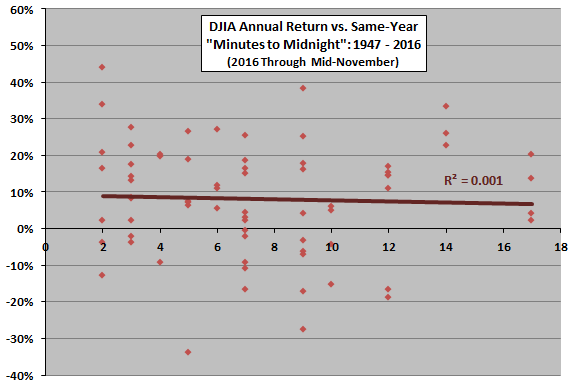Unless it's doom like getting caught on the wrong side of the Denarius/Shekel pair in A.D. 70 where it wasn't just the FX guys but the real estate developers out at the "Future site of Masada Manor" who got hammered.
Then it's a problem and you should probably brush up on your Latin.
From CXO Advisory:
Is proximity to doom good or bad for the stock market?
To measure proximity to doom, we use the Doomsday Clock “Minutes-to-Midnight” metric, revised occasionally via the Bulletin of the Atomic Scientists, which “conveys how close we are to destroying our civilization with dangerous technologies of our own making. First and foremost among these are nuclear weapons, but the dangers include climate-changing technologies, emerging biotechnologies, and cybertechnology that could inflict irrevocable harm, whether by intention, miscalculation, or by accident, to our way of life and to the planet.” Using the timeline for the Doomsday Clock since inception and contemporaneous annual returns for the Dow Jones Industrial Average (DJIA) during 1947 through most of 2016 (23 doom proximity judgments), we find that:
The following chart relates annual DJIA return (2016 partial) to same-year “Minutes to Midnight” judgment as available over the sample period based on two assumptions:
The Pearson correlation between these two series is -0.04 and the R-squared statistic 0.001, indicating practically no relationship between proximity to doom and annual DJIA return.
- Changes in “Minutes to Midnight” occur near the beginning of years. For example, the 3-minute proximity to doom for 2015 relates to the 2015 DJIA return of -2.2%.
- When there is no change for a given year, “Minutes to Midnight” is that same as the most recently issued judgment. For example, the proximity to doom for 2013 and 2014 is the same as that for 2012.
Might there be a lag between proximity to doom and stock market return?

The next chart summarizes annual correlations between “Minutes to Midnight” and DJIA annual return for lead-lag relationships ranging from DJIA return leads proximity to doom by five years (-5) to proximity to doom leads DJIA return by five years (5). All correlations are too small to indicate any relationship....MORE